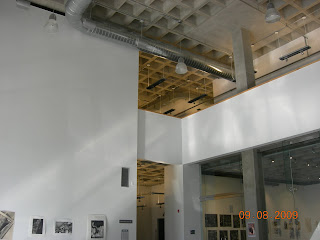
Instead of choosing a room in my home, I decided to study the entry @ UNCG's Gatewood Studio Art Center. I felt that this room would receive a lot of natural light and as a result, create interesting light patterns. Also, the reflective materials would reflect light in various ways.
First, here are some pics from the first day, 9/8/09 @ 4:30 pm





The light coming in to the lobby was extremely bright on this summer day, so bright that the contrast of light & dark was high. The interior metal halide lamps had not come on yet, so all the light was from daylight which entered into the lobby from the wall of windows at the entrance. Large diagonal shadows were cast on the terrazzo floor. The lighting is not fit for study because there is either to much glare or to much shadow.




